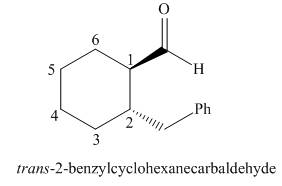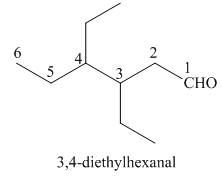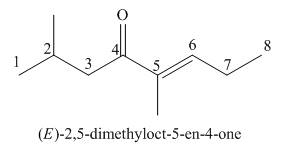
Concept explainers
Give the IUPAC name for each compound.
a.  c.
c.  e.
e. 
b.  d.
d.  f.
f. 
(a)
Interpretation: The IUPAC name for the given compound is to be stated.
Concept introduction: One should follow the given steps to give the IUPAC name of a ketone. The first step is finding of longest parent chain that contains a carbonyl carbon. The second step is changing of -e ending of the parent alkane to the suffix -one. The third step is numbering of chain to give the least number to carbonyl carbon, and using the general rules of nomenclature.
Answer to Problem 21.43P
The IUPAC name for the given compound is
Explanation of Solution
The given compound is a ketone.
One should follow the given steps to give the IUPAC name of a ketone. The first step is finding of longest parent chain that contains a carbonyl group. The second step is changing of -e ending of the parent alkane to the suffix -one. The third step is numbering of chain to give the least number to carbonyl carbon, and using the general rules of nomenclature.
The given structure shows the presence of six

Figure 1
Thus, the IUPAC name for the given compound is
The IUPAC name for the given compound is
(b)
Interpretation: The IUPAC name for the given compound is to be stated.
Concept introduction: One should follow the given steps to give the IUPAC name of an aldehyde. The first step is finding of longest parent chain that contains an aldehyde group. The second step is changing of -e ending of the parent alkane to the suffix -al. However, when an aldehyde
Answer to Problem 21.43P
The IUPAC name for the given compound is
Explanation of Solution
The given compound is an aldehyde.
One should follow the given steps to give the IUPAC name of an aldehyde. The first step is finding of longest parent chain that contains an aldehyde group. The second step is changing of -e ending of the parent alkane to the suffix -al. However, when an aldehyde
The given structure shows the presence of six

Figure 2
Thus, the IUPAC name for the given compound is
The IUPAC name for the given compound is
(c)
Interpretation: The IUPAC name for the given compound is to be stated.
Concept introduction: One should follow the given steps to give the IUPAC name of a ketone. The first step is finding of longest parent chain that contains a carbonyl carbon. The second step is changing of -e ending of the parent alkane to the suffix -one. The third step is numbering of chain to give the least number to carbonyl carbon, and using the general rules of nomenclature.
Answer to Problem 21.43P
The IUPAC name for the given compound is
Explanation of Solution
The given compound is a ketone.
One should follow the given steps to give the IUPAC name of a ketone. The first step is finding of longest parent chain that contains a carbonyl group. The second step is changing of -e ending of the parent alkane to the suffix -one. The third step is numbering of chain to give the least number to carbonyl carbon, and using the general rules of nomenclature.
The given structure shows the presence of six

Figure 3
Thus, the IUPAC name for the given compound is
The IUPAC name for the given compound is
(d)
Interpretation: The IUPAC name for the given compound is to be stated.
Concept introduction: One should follow the given steps to give the IUPAC name of an aldehyde. The first step is finding of longest parent chain that contains an aldehyde group. The second step is changing of -e ending of the parent alkane to the suffix -al. However, when an aldehyde
Answer to Problem 21.43P
The IUPAC name for the given compound is
Explanation of Solution
The given compound is an aldehyde.
One should follow the given steps to give the IUPAC name of an aldehyde. The first step is finding of longest parent chain that contains an aldehyde group. The second step is changing of -e ending of the parent alkane to the suffix -al. However, when an aldehyde
The given structure shows the presence of six

Figure 4
Thus, the IUPAC name for the given compound is
The IUPAC name for the given compound is
(e)
Interpretation: The IUPAC name for the given compound is to be stated.
Concept introduction: One should follow the given steps to give the IUPAC name of a ketone. The first step is finding of longest parent chain that contains a carbonyl carbon. The second step is changing of -e ending of the parent alkane to the suffix -one. The third step is numbering of chain to give the least number to carbonyl carbon, and using the general rules of nomenclature.
Answer to Problem 21.43P
The IUPAC name for the given compound is
Explanation of Solution
The given compound is a ketone.
One should follow the given steps to give the IUPAC name of a ketone. The first step is finding of longest parent chain that contains a carbonyl group. The second step is changing of -e ending of the parent alkane to the suffix -one. The third step is numbering of chain to give the least number to carbonyl carbon, and using the general rules of nomenclature.
The given structure shows the presence of eight

Figure 5
Thus, the IUPAC name for the given compound is
The IUPAC name for the given compound is
(f)
Interpretation: The IUPAC name for the given compound is to be stated.
Concept introduction: One should follow the given steps to give the IUPAC name of an aldehyde. The first step is finding of longest parent chain that contains an aldehyde group. The second step is changing of -e ending of the parent alkane to the suffix -al. However, when an aldehyde
Answer to Problem 21.43P
The IUPAC name for the given compound is
Explanation of Solution
The given compound is an aldehyde.
One should follow the given steps to give the IUPAC name of an aldehyde. The first step is finding of longest parent chain that contains an aldehyde group. The second step is changing of -e ending of the parent alkane to the suffix -al. However, when an aldehyde
The given structure shows the presence of six

Figure 6
Thus, the IUPAC name for the given compound is
The IUPAC name for the given compound is
Want to see more full solutions like this?
Chapter 21 Solutions
Organic Chemistry
Additional Science Textbook Solutions
EBK INTRODUCTION TO CHEMISTRY
Organic Chemistry (9th Edition)
General Chemistry: Principles and Modern Applications (11th Edition)
The Organic Chem Lab Survival Manual: A Student's Guide to Techniques
Chemistry: The Central Science (14th Edition)
- Need help with Compound A.arrow_forwardDraw a stepwise mechanism for the attached reaction that forms ether D. D can be converted to the antidepressant fluoxetine (trade name Prozac) in a single steparrow_forwardDraw a stepwise mechanism for the following reaction that forms ether D. D can be converted to the antidepressant fluoxetine (trade name Prozac) in a single step.arrow_forward
- Give the IUPAC name of the following: a, b, c, d, e, farrow_forwardDraw a stepwise mechanism for the following reaction that forms ether D. D can be converted to the antidepressant uoxetine (trade name Prozac) in a single step.arrow_forwardGive the IUPAC name for each compound.Can you help me with a, b and c please?arrow_forward
- Chemistry: Matter and ChangeChemistryISBN:9780078746376Author:Dinah Zike, Laurel Dingrando, Nicholas Hainen, Cheryl WistromPublisher:Glencoe/McGraw-Hill School Pub Co
 Chemistry for Today: General, Organic, and Bioche...ChemistryISBN:9781305960060Author:Spencer L. Seager, Michael R. Slabaugh, Maren S. HansenPublisher:Cengage Learning
Chemistry for Today: General, Organic, and Bioche...ChemistryISBN:9781305960060Author:Spencer L. Seager, Michael R. Slabaugh, Maren S. HansenPublisher:Cengage Learning Organic ChemistryChemistryISBN:9781305580350Author:William H. Brown, Brent L. Iverson, Eric Anslyn, Christopher S. FootePublisher:Cengage Learning
Organic ChemistryChemistryISBN:9781305580350Author:William H. Brown, Brent L. Iverson, Eric Anslyn, Christopher S. FootePublisher:Cengage Learning


